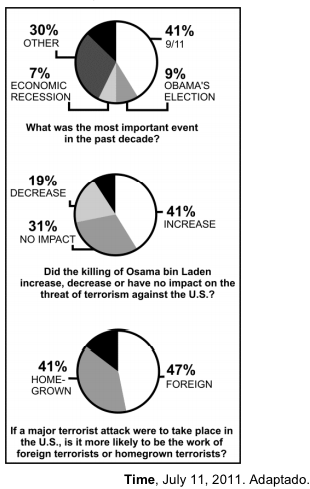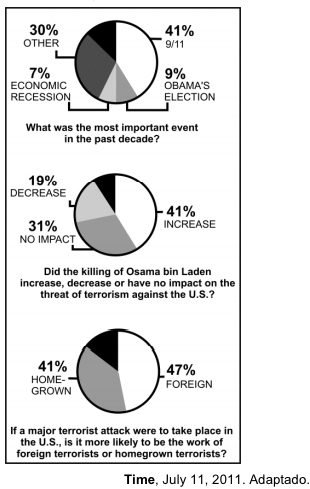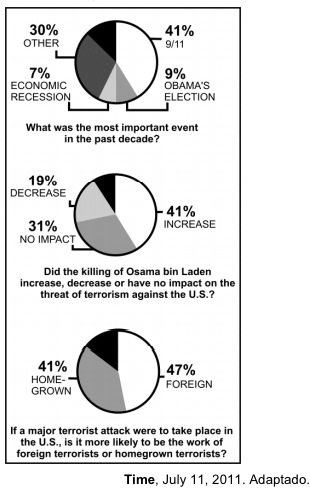JUST 10 YEARS INTO A NEW CENTURY, MORE THAN TWO-thirds of the country sees the past decade as a period of decline for the U.S., according to a new TIME/Aspen Ideas Festival poll that probed Americans on the decade since the tragic events of Sept. 11, 2001. Osama bin Laden is dead and al-Qaeda seriously weakened, but the impact of the 9/11 attacks and the decisions that followed have, in the view of most Americans, put the U.S. in a tailspin that the country has been unable to shake during two administrations and almost 10 years of trying.
ACCORDING TO THE POLL, ONLY 6% OF MORE THAN 2,000 Americans believe the country has completely recovered from the events of 9/11. Some of this pessimism can be tied to fears of more terrorist attacks. Despite the death of bin Laden, most Americans think another terrorist attack in the U.S. is likely.

A pesquisa descrita no texto mostrou que a maioria dos norte-americanos
Clique aqui e faça uma pergunta na sessão de comentários desta questão.
JUST 10 YEARS INTO A NEW CENTURY, MORE THAN TWO-thirds of the country sees the past decade as a period of decline for the U.S., according to a new TIME/Aspen Ideas Festival poll that probed Americans on the decade since the tragic events of Sept. 11, 2001. Osama bin Laden is dead and al-Qaeda seriously weakened, but the impact of the 9/11 attacks and the decisions that followed have, in the view of most Americans, put the U.S. in a tailspin that the country has been unable to shake during two administrations and almost 10 years of trying.
ACCORDING TO THE POLL, ONLY 6% OF MORE THAN 2,000 Americans believe the country has completely recovered from the events of 9/11. Some of this pessimism can be tied to fears of more terrorist attacks. Despite the death of bin Laden, most Americans think another terrorist attack in the U.S. is likely.

A sequência “most Americans think another terrorist attack in the U.S. is likely” significa que, para a maioria dos norte-americanos, outro ataque terrorista nos EUA é
Clique aqui e faça uma pergunta na sessão de comentários desta questão.
JUST 10 YEARS INTO A NEW CENTURY, MORE THAN TWO-thirds of the country sees the past decade as a period of decline for the U.S., according to a new TIME/Aspen Ideas Festival poll that probed Americans on the decade since the tragic events of Sept. 11, 2001. Osama bin Laden is dead and al-Qaeda seriously weakened, but the impact of the 9/11 attacks and the decisions that followed have, in the view of most Americans, put the U.S. in a tailspin that the country has been unable to shake during two administrations and almost 10 years of trying.
ACCORDING TO THE POLL, ONLY 6% OF MORE THAN 2,000 Americans believe the country has completely recovered from the events of 9/11. Some of this pessimism can be tied to fears of more terrorist attacks. Despite the death of bin Laden, most Americans think another terrorist attack in the U.S. is likely.

Com base nos gráficos que acompanham o texto, é correto afirmar que, para os norte-americanos,
Clique aqui e faça uma pergunta na sessão de comentários desta questão.
Although robots have made great strides in manufacturing, where tasks are repetitive, they are still no match for humans, who can grasp things and move about effortlessly in the physical world.
Designing a robot to mimic the basic capabilities of motion and perception would be revolutionary, researchers say, with applications stretching from care for the elderly to returning overseas manufacturing operations to the United States (albeit with fewer workers).
Yet the challenges remain immense, far higher than artificial intelligence obstacles like speaking and hearing. “All these problems where you want to duplicate something biology does, such as perception, touch, planning or grasping, turn out to be hard in fundamental ways,” said Gary Bradski, a vision specialist at Willow Garage, a robot development company based in Silicon Valley. “It’s always surprising, because humans can do so much effortlessly.”
http://www.nytimes.com, July 11, 2011. Adaptado
Segundo o texto, um grande desafio da robótica é
Clique aqui e faça uma pergunta na sessão de comentários desta questão.
Although robots have made great strides in manufacturing, where tasks are repetitive, they are still no match for humans, who can grasp things and move about effortlessly in the physical world.
Designing a robot to mimic the basic capabilities of motion and perception would be revolutionary, researchers say, with applications stretching from care for the elderly to returning overseas manufacturing operations to the United States (albeit with fewer workers).
Yet the challenges remain immense, far higher than artificial intelligence obstacles like speaking and hearing. “All these problems where you want to duplicate something biology does, such as perception, touch, planning or grasping, turn out to be hard in fundamental ways,” said Gary Bradski, a vision specialist at Willow Garage, a robot development company based in Silicon Valley. “It’s always surprising, because humans can do so much effortlessly.”
http://www.nytimes.com, July 11, 2011. Adaptado
De acordo com o texto, o especialista Gary Bradski afirma que
Clique aqui e faça uma pergunta na sessão de comentários desta questão.

A wave of anger is sweeping the cities of the world.
The protests have many different origins. In Brazil people rose up against bus fares, in Turkey against a building project. Indonesians have rejected higher fuel prices. In the euro zone they march against austerity, and the Arab spring has become a perma-protest against pretty much everything.
Yet just as in 1848, 1968 and 1989, when people also found a collective voice, the demonstrators have much in common. In one country after another, protesters have risen up with bewildering speed. They tend to be ordinary, middle-class people, not lobbies with lists of demands. Their mix of revelry and rage condemns the corruption, inefficiency and arrogance of the folk in charge.
Nobody can know how 2013 will change the world – if at all. In 1989 the Soviet empire teetered and fell. But Marx’s belief that 1848 was the first wave of a proletarian revolution was confounded by decades of flourishing capitalism and 1968 did more to change sex than politics. Even now, though, the inchoate significance of 2013 is discernible. And for politicians who want to peddle the same old stuff, news is not good.
The Economist, June 29, 2013. Adaptado.
Segundo o texto, os protestos de 2013, em diversos lugares do mundo,
Clique aqui e faça uma pergunta na sessão de comentários desta questão.

A wave of anger is sweeping the cities of the world.
The protests have many different origins. In Brazil people rose up against bus fares, in Turkey against a building project. Indonesians have rejected higher fuel prices. In the euro zone they march against austerity, and the Arab spring has become a perma-protest against pretty much everything.
Yet just as in 1848, 1968 and 1989, when people also found a collective voice, the demonstrators have much in common. In one country after another, protesters have risen up with bewildering speed. They tend to be ordinary, middle-class people, not lobbies with lists of demands. Their mix of revelry and rage condemns the corruption, inefficiency and arrogance of the folk in charge.
Nobody can know how 2013 will change the world – if at all. In 1989 the Soviet empire teetered and fell. But Marx’s belief that 1848 was the first wave of a proletarian revolution was confounded by decades of flourishing capitalism and 1968 did more to change sex than politics. Even now, though, the inchoate significance of 2013 is discernible. And for politicians who want to peddle the same old stuff, news is not good.
The Economist, June 29, 2013. Adaptado.
Ao comparar os protestos de 2013 com movimentos políticos passados, afirma-se, no texto, que
Clique aqui e faça uma pergunta na sessão de comentários desta questão.
To live the longest and healthiest life possible, get smarter. Institute for Health Metrics and Evaluation (IHME) data show that past a certain threshold, health and wealth are just weakly correlated. However, overall health is closely tied to how many years people spend in school. Mexico, for instance, has a fifth the per capita gross domestic product (GDP) of the United States, but, for women, more than 50 percent of the latter’s schooling.
In line with the trend, Mexico’s female adult mortality rate is only narrowly higher. Vietnam and Yemen have roughly equivalent per capita GDP. Yet Vietnamese women average 6.3 more years in school and are half as likely to die between the ages of 15 and 60. “Economic growth is also significantly associated with child mortality reductions, but the magnitude of the association is much smaller than that of increased education,” comments Emmanuela Gakidou, IHME’s director of education and training. “One year of schooling gives you about 10 percent lower mortality rates, whereas with a 10 percent increase in GDP, your mortality rate would go down only by 1 to 2 percent.”
Discover, May 31, 2013. Adaptado.
O argumento central do texto é o de que níveis mais altos de escolaridade estão diretamente relacionados a
Clique aqui e faça uma pergunta na sessão de comentários desta questão.
To live the longest and healthiest life possible, get smarter. Institute for Health Metrics and Evaluation (IHME) data show that past a certain threshold, health and wealth are just weakly correlated. However, overall health is closely tied to how many years people spend in school. Mexico, for instance, has a fifth the per capita gross domestic product (GDP) of the United States, but, for women, more than 50 percent of the latter’s schooling.
In line with the trend, Mexico’s female adult mortality rate is only narrowly higher. Vietnam and Yemen have roughly equivalent per capita GDP. Yet Vietnamese women average 6.3 more years in school and are half as likely to die between the ages of 15 and 60. “Economic growth is also significantly associated with child mortality reductions, but the magnitude of the association is much smaller than that of increased education,” comments Emmanuela Gakidou, IHME’s director of education and training. “One year of schooling gives you about 10 percent lower mortality rates, whereas with a 10 percent increase in GDP, your mortality rate would go down only by 1 to 2 percent.”
Discover, May 31, 2013. Adaptado.
No texto, ao se comparar o México aos Estados Unidos, afirma-se que, no México,
Clique aqui e faça uma pergunta na sessão de comentários desta questão.
To live the longest and healthiest life possible, get smarter. Institute for Health Metrics and Evaluation (IHME) data show that past a certain threshold, health and wealth are just weakly correlated. However, overall health is closely tied to how many years people spend in school. Mexico, for instance, has a fifth the per capita gross domestic product (GDP) of the United States, but, for women, more than 50 percent of the latter’s schooling.
In line with the trend, Mexico’s female adult mortality rate is only narrowly higher. Vietnam and Yemen have roughly equivalent per capita GDP. Yet Vietnamese women average 6.3 more years in school and are half as likely to die between the ages of 15 and 60. “Economic growth is also significantly associated with child mortality reductions, but the magnitude of the association is much smaller than that of increased education,” comments Emmanuela Gakidou, IHME’s director of education and training. “One year of schooling gives you about 10 percent lower mortality rates, whereas with a 10 percent increase in GDP, your mortality rate would go down only by 1 to 2 percent.”
Discover, May 31, 2013. Adaptado.
De acordo como texto, “about 10 percent lower mortality rates” é resultado de
Clique aqui e faça uma pergunta na sessão de comentários desta questão.
Página 1 de 2